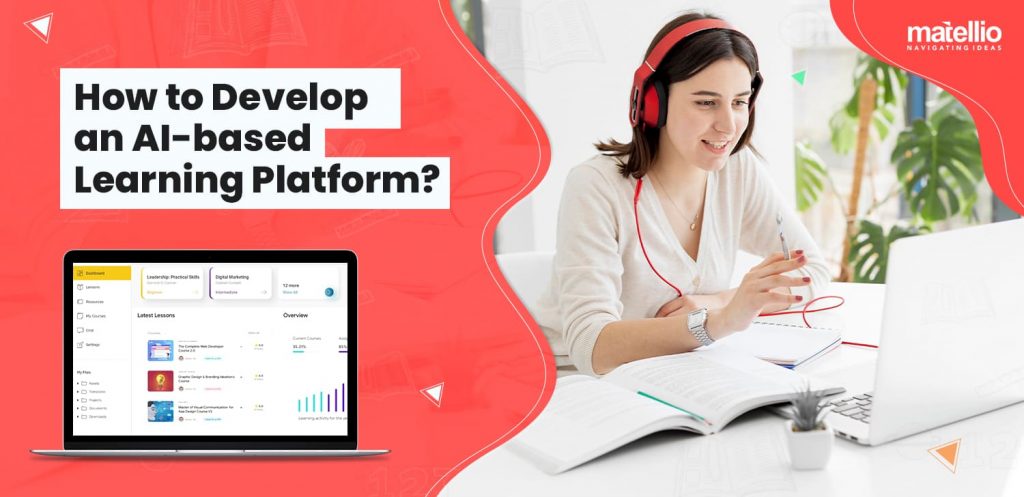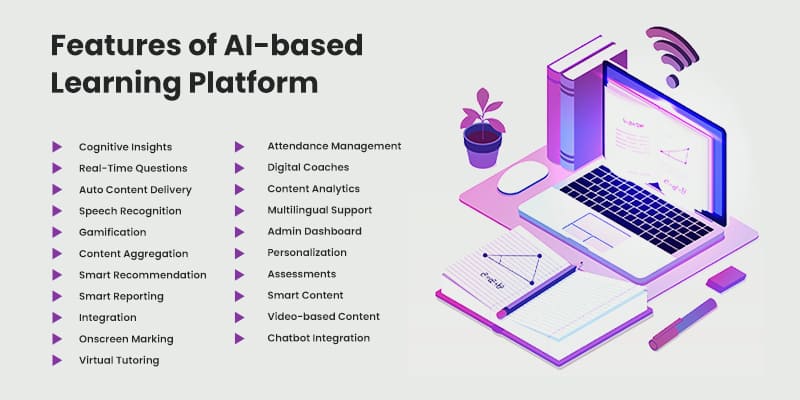
The industry with the highest rate of growth worldwide is the e-learning sector, which uses artificial intelligence to the fullest extent possible to enhance its offerings. Admins, users, and students all generally enjoy using AI-based learning platforms.
AI in eLearning provides everything the sector requires to transform it, enhance learning for all learners, and increase knowledge retention.
AI’s involvement in education is becoming increasingly significant. Today is the time to look for custom learning platforms powered by artificial intelligence (AI). In this blog, we’ll provide you with all the knowledge you need to develop an AI-based learning platform.
So, without any further ado, let’s get started!
AI-based Learning Platform: What & Why?
An AI-based elearning platform is a system with the capacity to carry out various tasks that call for the human intellect. It continues to develop answers for queries, it includes speech recognition, translations between languages, decision-making, and many more.
The learning platform gets new functionality from AI. It may assist you in finding fresh and fruitful approaches to meet the demands of your learners. Also, Artificial Intelligence (AI) is able to recognize patterns that individuals miss. To gradually personalize learning and produce the optimal outcome for each learner, AI solutions can make use of these patterns.
Moving ahead, let’s talk about,
Why You Must Use AI in a Learning Platform?
- AI can be used to translate spoken language into captions and transcripts, making it simpler for hearing-impaired people to understand the topic at hand.
- People with mobility limitations can use AI as a virtual assistant that reacts to voice commands. This will increase their level of engagement with the eLearning course and its associated products in the workplace.
- AI-based learning platforms are available around-the-clock, allowing learners to select the best time for learning. Additionally, there are no requirements to adhere to a teacher’s schedule or a rigid calendar of courses to enroll in.
- Use speech or an avatar to interact with the users as a virtual instructor imitating human encounters.
- Obtain information on the level of comprehension and the progress of the learner.
- The content can take on qualities connected to the student’s grammatical preparation thanks to the AI’s ability to foresee and adapt, which fosters a strong connection between the user and the developing topics. This results in content that is more approachable for users who speak their language and incorporates interactive aspects in accordance with their preferences and degree of understanding.
- Chatbots aided learning by responding to learner questions, offering more assistance, or customizing information based on performance.
- AI may monitor an individual’s past performance and use that information to modify the current learning material, creating a customized learning environment.
- AI can monitor student progress in an online course, identifying the areas where each student needs more practice and adjusting the content accordingly.
Also Read- The Future of AI in Software Development
What are the Must-have Features that You Need to Consider in AI Based Learning Platform?

The key features that you need to consider in a custom learning platform are:
1. Cognitive Insights
It is a sort of AI that searches through massive amounts of data for patterns using algorithms it has learned. In these scenarios, a machine learning (ML) component develops and knows efficient algorithms using correlation and trial and error. Traditional analytics are different from cognitive insight because the latter is significantly more in-depth and data-intensive. It often uses historical data to train itself, then uses predictions.
2. Integration
Having a learning platform that integrates with the apps your students use on a daily basis is important since it makes no sense to have all that personalized content available exclusively within your learning platform. This implies that educators can create engaging AI-powered content anywhere.
3. Real-time Questions
While learning takes place, many learners experience challenges when attempting to gain clarification on a particular subject. While some learners are confident enough to ask questions during the learning process, others are not. However, by including this function in your learning platform, you are able to give students the greatest way to get explanations whenever and however they like. With AI, students may ask questions about unclear material and receive prompt responses.
4. Auto Content Delivery
Additionally, admins need to perform fewer manual operations thanks to this feature in an AI-based learning platform. This will assist you in automating information delivery based on the parameters you select, such as when team members joined or if they have completed particular resources and courses.
5. Speech Recognition
NLP is a tool that can convert spoken language into written language. It is also called automatic speech recognition (ASR), computer speech recognition, or speech-to-text.
6. Gamification
You can use gamification methods, extract questions from learning objects, create quizzes, and give assessments using this functionality. To further engage learners, they might organize educational activities, remind recipients, and offer psychological and social rewards. Large volumes of data are processed to help identify student behavior and to keep them informed about their learning progress.
7. Content Aggregation
Each piece of content that AI encounters must have the capability of evaluation and categorization. This function automatically filters out irrelevant stuff to a learner’s journey and presents them with just the most pertinent and interesting content. It discovers the preferred learning forms for each student, such as games or webinars, then curates the course design based on past performance.
8. Smart Recommendation
The AI-based learning platform can recommend additional courses that are most appropriate for the user based on prior training sessions, exam results, work tempo, etc. These courses will have the best possibility of engaging the learner and making learning enjoyable. Without such suggestions, trainees frequently don’t even start the subsequent training session.
9. Smart Reporting
One of the most crucial tasks that enable the manager to evaluate the efficacy of the activities taken is smart monitoring and reporting both for learners’ performance and the progress of entire groups and departments. Based on the analysis of the daily data collected, reports and graphics are generated automatically. Reports are automatically generated, so the person overseeing learning does not need to create them themselves. They can also identify problem areas right away.
10. Chatbot Integration
AI chatbots can be employed to “assist” learners to engage cycle and personalise the educational experiences. Chatbots have the ability to perform a variety of learning functions, including offering enrollment services, assisting students, serving as mentors and tutors, answering frequently asked questions, guiding users through sessions, offering guidance, and determining effort. The fact that chatbot technologies provide trainees with practical opportunities for individualised coaching and mentorship is a major benefit. Get in touch with a company providing chatbot development services if you want chatbot development to offer Fair and equitable comprehensive training and genuine user experience for your trainees, make Learning and development approaches more constructive, more competent, accessible 24/7, answer frequently asked questions (FAQs), and boost effective learning.
11. Onscreen Marking
Assignments are a crucial component of the curriculum and are taken into account during evaluation. An LMS can serve as an interface where learners can upload their assignments and where the examiner can review the uploaded assignments. The OnScreen marking feature enables the examiner to check the assignment in online mode, assign grades, and provide comments on the responses; additionally, these remarks are visible to the applicants during the assignment review.
12. Virtual Tutoring
Based on user interactions, AI in the LMS system can develop virtual tutoring tools. The LMS establishes a communication channel that is reliant on AI, aiding in communication with the user through virtual tutors who act through voice. Additionally, lms developers can leverage this technology to enable the custom LMS software to provide gestural and vocal responses.
13. Attendance Management
The system automatically logs the attendance of attendees who are present online. The software allows for the efficient storage of attendance data and it’s repurposing whenever necessary. Attendance data can also be exported and filtered more quickly.
14. Digital Coaches
Imagine if your students had a dedicated coach to help them. This is now achievable within your learning platform because of the power of AI. For individuals who already have AI experience and a particular and pressing need, an AI digital coach within learning platforms is the perfect solution. Others may find better and less dangerous methods to spend money on integrating AI into learning platforms. Despite this, the future of digital coaches powered by AI is still quite promising.
15. Content Analytics
The learning modules are optimized thanks to this functionality. The content that is being taught to students via an e-learning platform can be evaluated for maximum impact with the use of artificial intelligence. Content creators and instructors can use content analytics not only to create and manage their content but also to acquire insightful information on the development and comprehension of the students. This can be used to improve the content so that learners receive a better education.
16. Multilingual Support
Multilingual support is necessary to increase the user base and the software’s extensive reach, regardless of whether the software is intended for a national or international audience. Students can comprehend more by expanding the target audience, learning about the app’s features and capacities, or offering a translation service.
17. Admin Dashboard
The instructor’s dashboard, known as the admin dashboard, gives them direct access to the users and pupils. This will enable greater participation and prompt evaluation of the pupils’ performance. Additionally, these dashboards allow professors to inform and keep students informed about any changes to the courses, tests, etc.
18. Personalization
Learners have high expectations for flexibility and want to be able to learn whenever and wherever they want. By examining their behavior, the courses they’ve interacted with most frequently, and their chosen learning style, this tool ensures individualized experiences for each of your learners. In order to provide a less linear but more efficient pathway to knowledge acquisition, this data is then utilized to understand what is most important to a learner and then to present courses that match all of this.
19. Assessments
Online assessments can be completed in a variety of ways. To start, conducting lectures and training sessions via videos and podcasts, often supported by AI-powered teaching assistants, can encourage conversation and simulate a classroom setting. Additionally, creating forums and online spaces where students may communicate and work together is a successful method of e-learning.
20. Smart Content
This feature combines learning environments and can be incorporated at all levels, from elementary through secondary and beyond. These days, practically all types of content are created by AI, which not only eases the workload of teachers but also improves student learning. This functionality can be used to create digital curricula and content for a variety of devices, including online assistants, audio players, and video players. This greatly improves and streamlines the learning process.
21. Video-based Content
Students can take advantage of useful features like zooming onto a specific image when viewing video content. Rewinding and fast-forwarding are both convenient at any time. The educational app market is flourishing, and video content is helping students and teachers.
Read More: How AI solutions for education enhance learning experiences, improve student outcomes, and transform educational practices.
 As of now, we’ve discussed a lot about AI-based learning platforms. Now, let’s move forward and discuss,
As of now, we’ve discussed a lot about AI-based learning platforms. Now, let’s move forward and discuss,
How to Develop an AI-based Learning Platform?
Here are some tips for building an AI-based learning platform. So, take a look!
1. Discuss Your Idea
Why do you require such a system? Is this a result of everyone shifting to digital solutions?
Understanding why you want to choose this road is crucial. Do you want to deliver education widely? To increase information retention rates? What exactly is it? You must be extremely clear about your motivations.
2. Build Project Architecture
Key components, a hosting network, and the software design with data modules are part of the software system’s basis, called product architecture. By planning the product architecture, you can make sure the software system satisfies the demands of the present while also allowing for the consideration and accommodation of future demands.
3. Partner with Top AI Software Development Company
The development of AI-based learning platforms demands a thorough knowledge of the underlying technologies. The best alternative, if you lack the necessary knowledge, is to work with a reputable AI software development company.
The following set of activities will guide your decision-making:
- Examine the client feedback that is currently available.
- Analyze relevant AI app development experience
- Check portfolio
- Check development team size
4. Choose the Right Tech Stack
To design your solution, you must select the technology stack as part of custom LMS development. The following technologies can aid in the building of an e-learning platform:
- Java
- Python
- Tensorflow
- PyTorch
- Keras
- Darknet
- C#
Also, remember that the needs of a company for whom an AI solution is built are the sole determinants of the technology to be used.
5. Design UI/UX
It’s time to dive into the finer details of design once you’ve established your requirement for custom software, established your goals and outcomes, and worked out the scope of work with your development team.
You and the team decide what your software needs, how long it will take to develop during the design phase. Workflows need to be mapped out now. A good design should be easy for users to grasp and comprehend. Consider the primary navigation features and the number of functionality components you want them to have. The most effective approach to achieving that is to see yourself using the platform.
6. Build MVP
A fantastic approach for determining whether a product concept is viable is the Minimum Viable Product. It’s also less expensive than producing a finished application right away. It is a streamlined version of the software product that enables you to acquire a quick reaction and assessment from the intended market. Users that are already interested in the condensed version of your software are particularly helpful because they can give you honest feedback and can even end up becoming your first users. The development of an MVP is a useful but not fully necessary step. The client has the option of skipping the MVP phase and developing the whole software right away.
Also Read: MVP Development for Startups
7. Start Development
This stage of the AI-based learning platform development involves writing code to translate the design and documentation into a functioning piece of software. Tasks are divided based on the development approach, and the product can be finished by the specified deadline. A number of important documents are developed, such as the design document, the functional requirement specification document, and the coding guidelines that will be used for the final delivery. AI integration services are crucial at this stage to ensure seamless incorporation of AI capabilities into the platform. In many respects, this step serves as the foundation for the entire project. As a result, completion normally takes some time.
8. Test Your Software
Strict quality control must be performed on the product before it is released onto the market. The ability to confirm that the business objectives were achieved during the development process and that the software’s code is error-free makes this phase of software development unique from all others.
Both a QA team and the developers themselves are capable of carrying out the testing methods. Testing will indeed also be beneficial later on when your software is being maintained. You may run all of your test cases after making a tiny change to see where your modifications might have broken other areas of the system. Your product will be of greater quality if you put more work into this process.
Conclusion
Online training can be made more effective and efficient with the use of AI-based learning platforms! Additionally, they assist in automating low-value repetitive procedures to lighten their workload and avoid mistakes!
Therefore, if you have questions about AI-based learning platforms and want to start with elearning platform development , get in touch with a reputable and experienced elearning Software development company with AI capabilities that can better assist you throughout the process and turn your concept into a reality, which would produce excellent outcomes.



